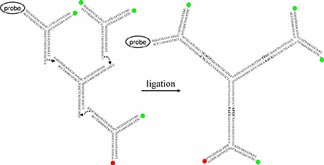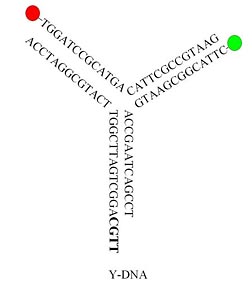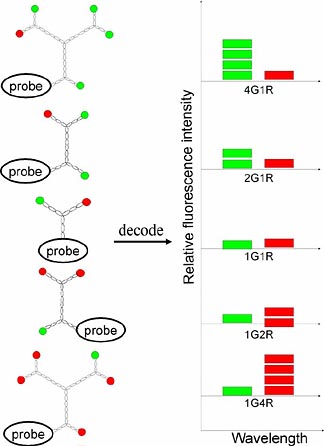Abstract:
Cornell researchers make synthetic DNA 'barcodes' to tag pathogens, providing an inexpensive, off-the-shelf monitoring system
DNA 'barcodes'
June 13, 2005
A supermarket checkout computer can identify thousands of different items by scanning the tiny barcode printed on the package. New technology developed at Cornell University could make it just as easy to identify genes, pathogens, illegal drugs and other chemicals of interest by tagging them with color-coded probes made out of synthetic tree-shaped DNA.
A research group headed by Dan Luo, Cornell assistant professor of biological engineering, has created "nanobarcodes" that fluoresce under ultraviolet light in a combination of colors that can be read by a computer scanner or observed with a fluorescent light microscope.
Other methods of identifying biological molecules that are available or being developed mostly involve expensive equipment, Luo said. "We wanted something that could be done with inexpensive, readily available equipment," he said. Several years ago researchers created probes consisting of nanoscale bars of metal actually etched with conventional bar codes. Since then, most molecular tagging devices have been referred to as "barcodes," even though there are no bars involved.
The researchers have tested their system using samples containing various combinations of E. coli, anthrax and tularemia bacteria and ebola and SARS viruses, and have found the color codes could clearly distinguish several different pathogens simultaneously.
The research is described in a paper, "DNA fluorescence nanobarcodes for multiplexed pathogen detections," by Luo, Yougen Li, a former Cornell graduate student now at California Institute of Technology, and Yen Thi Hong Cu, a current graduate student, to be published in the July 2005 issue of the journal Nature Biotechnology and available after June 12 in the online version of the journal.
The idea is one of several applications the researchers have found for what they call "dendimer-like DNA," consisting of many short Y-shaped strands of DNA linked together in a treelike structure. The DNA that carries the genetic code in living cells consists of two complementary strands that attach to one another along their length. But Luo's research purposely and completely ignores the DNA's genetic coding properties. He uses DNA, he said, as a "generic instead of a genetic material."

Several Ys can be joined to form a tree with many open ends, to which dye molecules or probes can be attached with precision.
|
By synthesizing three short strands of DNA, each of which is complementary to one of the others along half its length, the researchers can create a Y-shaped structure. Combining several of these structures creates a web with many branching ends. "While DNA is flexible, the short strands used here are quite rigid," Luo said. "A long piece of spaghetti is floppy, but a short bit of it is quite stiff."
An antibody or some other molecule that will bind to the molecule to be detected is attached to one of the loose ends of the DNA. To other ends are attached molecules of fluorescent dye in a predetermined pattern.
For example, one probe might contain four molecules of green dye and one of red. Another might have three molecules of green and two of red, and so on. If a mixture of several probes is added to a solution containing, for example, E. coli bacterial DNA, only probes with a particular color code will be programmed to bind to that DNA. The results can be seen under a fluorescent light microscope using colored filters that pass only one color at a time. A signal in which the ratio of intensity of green light is four times that of red light, for example, identifies a "4G1R" probe. The researchers say that up to 1,000 different codes can be created using only three fluorescent dyes.
To amplify the signals, the researchers attached many DNA probes to the surface of polystyrene microbeads 5.5 microns (millionths of a meter) in diameter. The results can be read in several ways. One is in a flow cytometer, in which samples move rapidly past a window where a computer reads the color codes of individual beads. Another is by dot blotting, in which the sample is spread on a sheet of absorbent paper and made visible to the naked eye. Or the color can be observed directly through a fluorescent light microscope, which is useful in situations where the geographic distribution of the target molecules is important, Luo said.
For convenience, a computer can convert the subtle differences in light intensity between, say 4G1R and 3G1R, into "pseudo colors," perhaps making one appear as orange and the other as pink, to make the difference clear to a human eye.
The researchers point out that the nanobarcode detection system does not require complex preparation of a sample and can be applied to living cells. The technology could be used in genomic research, clinical diagnosis, drug testing, environmental monitoring and monitoring for biological terrorism, they suggest.
Further details on "tree-shaped" DNA appear in a paper in Nature Materials (Vol. 3, Pg. 38-42, 2004).
Related World Wide Web sites: Dan Luo's Molecular Bioengineering Lab at Cornell
Contact:
Bill Steele
Office: (607) 255-7164
ws21@cornell.edu
Media Contact:
Blaine P. Friedlander Jr.
Phone: (607) 254-8093
E-mail: bpf2@cornell.edu
Copyright © Cornell University
If you have a comment, please Contact us.
Issuers of news releases, not 7th Wave, Inc. or Nanotechnology Now, are solely responsible for the accuracy of the content.
| Related News Press |
Possible Futures
![]() Discovery points path to flash-like memory for storing qubits: Rice find could hasten development of nonvolatile quantum memory April 5th, 2024
Discovery points path to flash-like memory for storing qubits: Rice find could hasten development of nonvolatile quantum memory April 5th, 2024
![]() With VECSELs towards the quantum internet Fraunhofer: IAF achieves record output power with VECSEL for quantum frequency converters April 5th, 2024
With VECSELs towards the quantum internet Fraunhofer: IAF achieves record output power with VECSEL for quantum frequency converters April 5th, 2024
Nanomedicine
![]() New micromaterial releases nanoparticles that selectively destroy cancer cells April 5th, 2024
New micromaterial releases nanoparticles that selectively destroy cancer cells April 5th, 2024
![]() Good as gold - improving infectious disease testing with gold nanoparticles April 5th, 2024
Good as gold - improving infectious disease testing with gold nanoparticles April 5th, 2024
![]() Researchers develop artificial building blocks of life March 8th, 2024
Researchers develop artificial building blocks of life March 8th, 2024
Announcements
![]() NRL charters Navy’s quantum inertial navigation path to reduce drift April 5th, 2024
NRL charters Navy’s quantum inertial navigation path to reduce drift April 5th, 2024
![]() Discovery points path to flash-like memory for storing qubits: Rice find could hasten development of nonvolatile quantum memory April 5th, 2024
Discovery points path to flash-like memory for storing qubits: Rice find could hasten development of nonvolatile quantum memory April 5th, 2024
Homeland Security
![]() The picture of health: Virginia Tech researchers enhance bioimaging and sensing with quantum photonics June 30th, 2023
The picture of health: Virginia Tech researchers enhance bioimaging and sensing with quantum photonics June 30th, 2023
![]() Sensors developed at URI can identify threats at the molecular level: More sensitive than a dog's nose and the sensors don't get tired May 21st, 2021
Sensors developed at URI can identify threats at the molecular level: More sensitive than a dog's nose and the sensors don't get tired May 21st, 2021
![]() Highly sensitive dopamine detector uses 2D materials August 7th, 2020
Highly sensitive dopamine detector uses 2D materials August 7th, 2020
|
|
||
|
|
||
| The latest news from around the world, FREE | ||
|
|
||
|
|
||
| Premium Products | ||
|
|
||
|
Only the news you want to read!
Learn More |
||
|
|
||
|
Full-service, expert consulting
Learn More |
||
|
|
||










